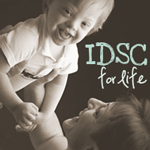I came across an article at healthnews.com through my Google Alerts today.
January is National Birth Defects Prevention Month.
The article below from healthnews.com is a good article, encouraging help for babies & mothers. But, the truth is that a major part of this so called, "prevention" includes abortion, whether the public wants to admit it or not. So, I thought I'd post this incase anybody has any ideas on any awareness that can be spread from the DS community. I know the awareness may not necessarily be the kind of awareness that is being encouraged, but nonetheless something may be able to be done I think.
I hope to be able to spread a lot of awareness this month by giving copies of our book to doctors, hospitals & even the general public.
National Birth Defects Prevention MonthQadoshyah
By: Lara Endreszl
Published: Monday, 5 January 2009
Infants are by far the most fragile form of life that hospitals and families help bring into this world because they are new and have no way of telling us if something is wrong. November was Premature Baby Awareness Month and now it is no surprise that January is National Birth Defects Prevention Month, because babies are a high priority.
A birth defect is defined as a structural, functional, or metabolism abnormality and several thousand of them have been recorded throughout history. As a leading cause of infant mortality including over 20 percent of all infant deaths in the United States each year, the impact of birth defects is greater than anyone would care to think about. There are 18 birth defects common to the rest of the infant population that survive the initial diagnosis and the estimated cost to provide care for those infants is more than $8 billion. According to the National Birth Defects Prevention Network (NBDPN) nearly 70 percent of birth defects are caused by unknown circumstances. Other causes include genetic and environmental factors or any combination of the two. Factors such as quality of life for the mother and baby, history of certain disorders, gene defects, etc, can all cause birth defects.
Research done by the NBDPN says that there are currently 37 states with operational birth defect facilities, 8 states with plans for operational facilities, and still 5 states without any functioning data centers for birth defect research. The main Centers for Birth Defects Centers for Research and Prevention are in the following states providing incredible investigations into trends among infants born with certain defects, innovative prevention tactics, and developing policies for children living with these disorders: California, Texas, Arkansas, Iowa, Georgia, Massachusetts, North Carolina, New York and Utah.
Each January the NBFPN develops a theme in which to provide information relating to birth defects and prevention in a concentrated way. The theme for 2009 is “Getting Fit for Pregnancy,” helping newly pregnant women to deal with the pressures of keeping their bodies healthy while eating for two or more. By spreading national awareness with their theme, many women can benefit from knowing the risks involved in carrying a baby by having the stress of excess weight on their bodies prior to conception. Obesity is a growing epidemic and women who fall into a specific weight bracket in conjunction with their age and height, tend to have riskier pregnancies as a result of the body’s added exertion and are more likely to have hypertension, preeclampsia or gestational diabetes.
With an estimated 120,000 babies born each year in America with birth defects, one in every 33 infants struggles to stay alive each day. Down syndrome, cleft lip or palate, and spina bifida are among the most common birth defects dealt with on a daily basis. Other birth defects include a type of dwarfism called Achondroplasia, a disease affecting connective tissue called Marfan syndrome, a nervous system disease called Tay-Sachs, cystic fibrosis, hemophilia, muscular dystrophy, heart defects, and other musculoskeletal, eye and gastrointestinal defects. To keep your children and their future children safe from birth defects, spread the awareness in order to garner attention and gain support and donations in order to open research facilities in all states and keep prevention—and future infants—healthy.






















